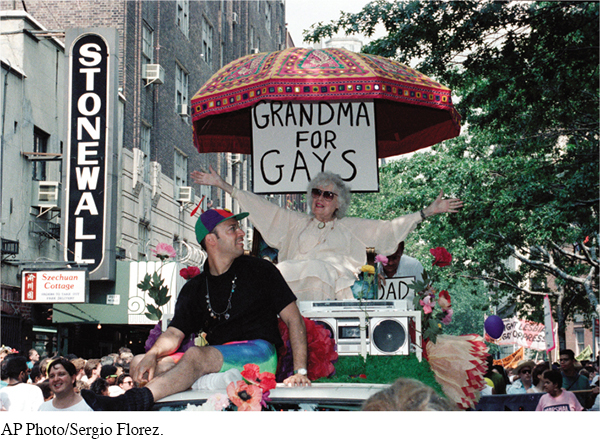The Gay and Lesbian Rights Movement
In contrast to feminism and other social movements, gay and lesbian rights activism grew during the 1980s, galvanized in part by the discovery in 1981 of a devastating disease, acquired immune deficiency syndrome (AIDS). Because initially the disease disproportionately affected male homosexuals in the United States, activists mobilized to promote public funding for AIDS education, prevention, and treatment.
The gay and lesbian rights movement encouraged closeted homosexuals to “come out,” and their visibility increased awareness, if not always acceptance, of homosexuality among the larger population. Beginning with the election of Elaine Noble to the Massachusetts legislature in 1974, several openly gay politicians won offices ranging from mayor to member of Congress, and the Democrats began to include gay rights in their party platforms. Activists organized gay rights marches throughout the country, turning out half a million people in New York City in 1987.[[LP Photo: P30.09 Gay Rights Parade/

Popular attitudes about homosexuality moved toward greater tolerance but remained complex, leading to uneven changes in policies. (See “Analyzing Historical Evidence: Protecting Gay and Lesbian Rights.”) Dozens of cities banned job discrimination against homosexuals, and beginning with Wisconsin in 1982, some states made sexual orientation a protected category under civil rights laws. Local governments and large corporations began to offer health insurance and other benefits to same-sex domestic partners.
> COMPARE AND CONTRAST
How did the gay and lesbian rights movement fare during the 1980s in comparison to the women’s movement and movements for racial justice?
Yet a strong countermovement challenged the drive for gay rights. The Christian Right targeted gays and lesbians as symbols of national immorality, and when the AIDS epidemic appeared, some fundamentalists believed that it represented “the wrath of God upon homosexuals.” Conservatives succeeded in overturning some homosexual rights measures, which already lagged far behind protections for women and minorities. Many states removed antisodomy laws from the books, but in 1986 the Supreme Court upheld the constitutionality of such laws. Until the Court reversed that opinion in 2003, more than a dozen states retained statutes that left homosexuals vulnerable to criminal charges for private consensual behavior.
> QUICK REVIEW
What gains and setbacks did minorities, feminists, and gays and lesbians experience during the Reagan years?
Understanding the American Promise 3ePrinted Page 876
Section Chronology